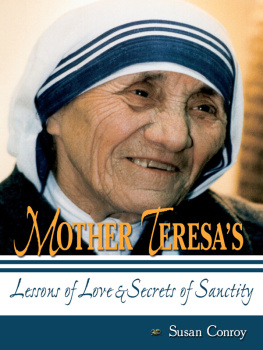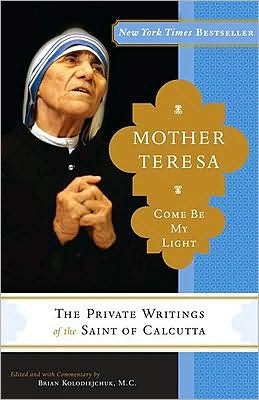Copyright 2019
Kakadu, LLC
Published by Blue Sparrow
All rights reserved.
No part of this book may be used or reproduced in any manner whatsoever without permission except in the case of brief quotations in critical articles or reviews.
The quotes in this book have been drawn from dozens of sources. They are assumed to be accurate as quoted in their previously published forms. Although every effort has been made to verify the quotes and sources, the Publisher cannot guarantee their perfect accuracy.
Design by Ashley Wirfel
ISBN: 978-1-63582-120-8 (hardcover)
ISBN: 978-1-63582-121-5 (e-Book)
10 9 8 7 6 5 4 3 2 1
Printed in the United States of America
FIRST EDITION
Table of Contents
Introduction:
Encountering a Saint
IT HAS BEEN twenty years since Mother Teresa died. She died humbly while the whole world was looking the other way. The world was obsessed with the death and funeral of Princess Dianna and Mother Teresa took that opportunity to slip from this world into the arms of her loving God.
Mother Teresa captured the imagination of the whole worldjust as the first Christians didby radically embracing the Gospel message of Jesus.
People from every corner of the world were intrigued with her life and her work. Men, women, and children were fascinated with this Catholic nun in Calcutta. Such is the allusive power of holiness.
She is truly a modern example of how universally attractive holiness is.
Who loved Mother Teresa? Just Catholics? No. Just Christians? No. Mother Teresa was beloved by men and women of all faiths and men and women of no faith. Why? Because there is simply nothing more attractive than holiness. Holiness is irresistible.
Here are just some of the things other people have said about the Saint of Calcutta:
Mother Teresa marked the history of our century with courage. She served all human beings by promoting their dignity and respect, and made those who had been defeated by life feel the tenderness of God.
Pope John Paul II
When she walked into the room to greet me, I felt that I was indeed meeting a saint.
The Reverend Billy Graham
Mother Teresa is the United Nations. She is peace in the world.
Javier Perez de Cuellar, former U.N. Secretary General
Mother Teresa personified a boldness of spirit and purity of soul revered by the entire world She served as a model of holiness, virtue, and humility.
Ronald and Nancy Regan, 40th President of the United States and First Lady
A loss to the entire humanity. She will be deeply missed in our efforts to build international peace, and a just, caring, and equitable world order.
Nelson Mandela, former President of South African
Our world has lost the most celebrated saint of our times. This courageous woman gave hope to millions, and showed us the power of caring and human kindness.
Coretta Scott King, civil rights leader and widow of Martin Luther King, Jr.
This evening, there is less love, less compassion, less light in the world. She leaves us a strong message, which has no borders and which goes beyond faith: helping, listening, solidarity.
Jacques Chirac, French President
But each person who encountered Mother Teresa had his or her own experience. Now it is your turn to encounter her or re-encounter her. Her life and her message are timeless. She reaches deep into our hearts, minds, and souls and challenges us to embrace the beautiful generosity of our own humanity.
Biography:
She Captured the Imagination of the Whole World
MOTHER TERESA was born Agnes Bojaxhiu in Serbia on August 26, 1910. Agnes grew up in Albania, surrounded by wealth and prosperity. Despite their wealth, her parents were models of virtue. They loved each other deeply, and that love overflowed to Agnes and her sister. At the age of eighteen, Agnes left home to join an Irish order of nuns. Later that year, in December 1928, she set sail for India to begin her work as a novice for the Loreto Order. Now Sister Teresa, she spent most of the next twenty years teaching. In 1937, she made her permanent vows of poverty, chastity, and obedience, and as was customary adopted the title of Mother.
By 1943, India was torn by war and famine. Mahatma Gandhis great success in freeing India from British rule had become tainted by civil war between Muslims and Hindus living in India. More people than ever descended upon Calcutta. It finally became necessary for the Loreto Convent to move the children and the school outside the city. At this time, many nuns and whole orders decided to leave India and close their schools, but Mother Teresa stayed and worked tirelessly. As others left, she taught more and more classes, eventually teaching two subjects to eight grades.
She was happy in her work and well liked. By the mid-1940s, her mere presence already had a power that had been born through hours of prayer and reflection. Soon Mother Teresa was appointed headmistress, and she wrote to her mother, This is a new life. Our center here is very fine. I am a teacher, and I love the work. I am also head of the whole school, and every- body wishes me well. Her mothers reply was a stern reminder of her original intentions for going to India: Dear child, do not forget that you went to India for the sake of the poor.
Kipling described Calcutta as the city of a dreadful night. Mother Teresa was in the capital of poverty, a poverty that most people never even witness firsthand, let alone personally experience. Have you been there? Have you seen it on television? Can you picture it?
This was the world that surrounded the school and this was the world that was crying out for help.
In 1946, Mother Teresa became very ill herself and was ordered by doc- tors to have bed rest for three hours every afternoon. It was very hard for her to rest and not do her work, but this period of enforced rest culminated in the directive to go away on retreat for a month. The intention was that in the interests of her health she should undergo a period of spiritual renewal and a physical break from the work.
On September 10, 1946, she boarded a train for Darjeeling, where she was to retreat. Aboard that train, Mother Teresa had a supernatural experience that changed the direction of her life forever. She referred to it as the call within the call. Many years earlier she had been called to religious life (the call). Now she was being called to something more (the call within the call). The retreat provided the perfect period of silence, solitude, and prayer to follow the experience God had given her on the train.
The next couple of years were filled with dialogue between her spiritual director, the Bishop, and Rome. By 1950, at age forty, Mother Teresa had left the school and the Loreto Order, founded the Sisters of Charity, and was living among the poorest of the poor in Calcutta. At this time she began a new life, dreamt a new dream. She stepped into the classroom of silence, sat down with her God, and said, How can I help? Over the next twenty years she would capture the imagination of the whole world simply by living the Gospel. Such is the potency and spellbinding power the Gospel holds when it is actually lived.















